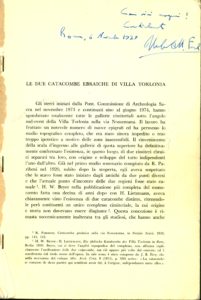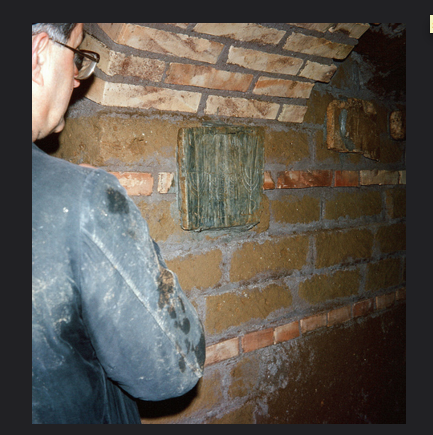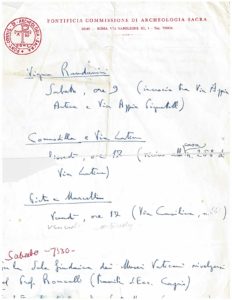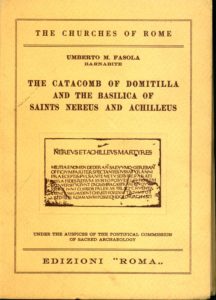
Umberto M. Fasola's dedication to Estelle Brettman of a copy of his 1976 article on the Jewish Catacombs of Villa Torlonia (ICS archives)
In 1976, the Rivista di Archeologia Cristiana published Fr. Umberto M. Fasola’s report on the excavation of two Jewish catacombs below the Villa Torlonia in Rome. The dig had been made between 1973 and 1974 at the start of Fasola’s tenure as secretary of the Pontifical Commission for Sacred Archaeology (PCAS), the Vatican entity that, since 1929, had held custodianship of Italy’s “sacred cemeteries”, including a small number of ancient burial grounds used by Jews. The reasons for the arrangement were more pragmatic than ideological. The PCAS, instituted as the Commission for Sacred Archaeology (CDAS) in 1852, had been successful in preserving large tracts of catacombs around Rome. In the case of Jewish sites unexpectedly coming to light from time to time between 1859 and 1919, PCAS intervention could go only so far, as the Vatican coffers were closed to catacombs “without any signs of Christianity”. PCAS officers did, as Fasola put it, "discover (the Jewish catacombs), explore them... and write about them," but by Fasola's own account, could not stop the "damages of modern urbanization," even today forcing these sites to crumble. For that, only a cash intervention would do. The Church made exceptions only for elaborately decorated underground tombs that resembled in structure and appearance the Christian sites. The Lateran Museum’s acquisition of a large quantity of Jewish tomb artifacts from a burial site inconveniently located on a land parcel up for sale around 1910, however, seems to have compelled the Church to take on a more active role in documenting the patrimony of Rome’s ancient Jews. The largest collection of ancient Judaica to date was now in its possession, donated to the Church by the owners of the Jewish cemetery from whence the artifacts had come, members of the Papal "black nobility" who sought, in return, the site's total demolition. Following public outcry over the government's complicity in the act, and numerous other reports of catacomb vandalizing and destruction, Italy’s Education Ministry in 1912 turned over all the catacombs in the Rome province to the PCAS, including those of the Jews. A formal treaty between the newly sovereign Vatican State and Italy in 1929 ratified this accord. Even then, control over a small number of Jewish cemeteries was treated as a minor affair. A lot was left to circumstance, and the country's descent into wartime chaos left matters as they stood, though the sites themselves, like the rest of the country, did not escape intrusion.
The Church’s custodianship of the Jewish cemeteries was not contested with vigor until the late 1960’s. Various factions within Italian society were then ready to challenge the Fascist-era agreement between Church and State. Jews lent their voice to this discussion. Nostra Aetate, the 1965 Papal Encyclical that defined in an unprecedented manner the legitimacy of non-Christian religions had not ended the privileges of the Church in secular settings. As the PCAS’s new secretary in 1971, Fasola inherited from his predecessor, Fr. Antonio Ferrua, SJ, an administrative role over the Jewish catacombs very likely to change form with a treaty revision, though no one could say as of yet when and how the process would unfold.
A shaft of light through the gathering clouds was a growing public awareness of the existence of Jewish catacombs in Rome and Venosa. They inspired not only polemic about a constant risk of decay, but also the curiosity of international travelers and scholars, who now had at their disposal important studies in English on Jewish archaeological finds in Italy, notably E. R. Goodenough’s Jewish Symbols in the Greco-Roman Period (1953-1968), and H. J. Leon’s The Jews of Ancient Rome (1960). Together with the discovery of a synagogue building in Ostia Antica in the early 1960’s, these works rekindled the hope that it was possible to recover something concrete about Italian Jewish communities all but lost to history.
The attention put the PCAS in an awkward position. It had right of access to the Jewish catacombs. Getting inside was another story. The sites were on private land. The Torlonia catacombs, in particular, disappeared from the public radar almost immediately after they were discovered in 1919, for Prince Giovanni Torlonia's new tenant on the Nomentana estate in 1925 was none other than Fascist leader Benito Mussolini. For the entire period of Mussolini’s tenancy and the Second World War, these tunnels were open only to military personnel. Even so, a PCAS inspection in 1946 reported the Jewish cemetery desecrated and robbed, with bones strewn about the galleries, graffiti defacing the walls, and documented artifacts gone missing. One or more parties might have been responsible – Fascists, allied troops now on site, and, most likely, Torlonia, who had repositories of antiquities all over Rome. At any event, the burial grounds were locked down once more while the Torlonia heirs squabbled with each other and the city about site ownership and building rights. Held up in the Italian courts, an already dubious situation became even more confused. Foreigners, in particular, could not grasp why a powerful entity like the Roman Catholic Church seemed inert and ineffectual in this situation. The PCAS, in turn, approached Rome’s Jewish community with proposals for collaboration, but in vain. Jewish leaders were not going to accept that “their” catacombs were in the hands of the very institution responsible for the destruction of countless Jewish possessions. A much larger historical problem complicated the issue at stake.
For about five years during the 1970’s, Fasola thought it politically expedient to keep the Torlonia catacombs open by request to counteract charges largely stemming “from a misinformed press” that the PCAS was going out of its way to hide them. This was possible until the Villa Torlonia became public property in 1977, and a new procedure for access was required. In that time, Jews of many nationalities saw the cemetery site, not only rabbis and community leaders, but also university students and families with children. Those who recall the experience speak of a tall priest in a black coat who communicated with them in German, French, and Italian. This is a description of Fr. Fasola, the ultimate scholar-guide.
One visitor to the Villa Torlonia catacombs in June of 1976 was Estelle Shohet Brettman, an American Jew from Boston. Somewhat exceptionally, she asked to see not only the Jewish catacombs, but also those of the Christians. And she returned many times, looking for evidence of what she claimed was a “syncretism and a subsequent evolution of iconographies and symbols”. Fasola agreed to Brettman’s requests for study tours, but was not sure of her intentions. She had come to the PCAS by recommendation of the United States ambassador to Italy, who routinely passed on to Fasola the requests for catacomb tours. Not long after her first visit, Brettman told Fasola that she was going to contact Jewish leaders in the United States and Italy about raising funds for the Jewish catacombs. She refused to name names, but reassured the Barnabite priest that she fully supported his “efforts to preserve the Jewish catacombs from tragic deterioration” and his controversial decision in 1978 to bury the stairways into the Torlonia site. Brettman’s desire that the Vatican remain somehow involved in the Jewish catacombs’ upkeep must have resonated with Fasola – as he wrote to Jewish Community President Pietro Blayer, “I love these sites”. Accusations of “cleaning out” the Jewish tombs and only bothering with them when they were about to collapse had greatly upset him. The woman from Boston seemed, as he put it, "enthusiastic, prepared, and precise," not to mention committed to the issue in a very different way than the prominent Italian Jews who campaigned for the Jewish catacombs' "liberation". Yet he was unable to shake the feeling, as he wrote to a Vatican colleague, that “there was something strange about this woman” (Brettman). She was about to do something to confuse him – and anger him – even more.
What Brettman did was to make good on her word to approach leaders among the Jews in America about forming a non-sectarian committee to “support and guide the Italian Jewish community in necessary fund-raising procedures and archaeological problems”. By her own claim, Rome’s Chief Rabbi, Elio Toaff, and others from the Union of Jewish Communities of Italy (UCEI) were “very anxious” to work with her if she was made administrator of “an international committee whose only goals are the conservation and further study of the Jewish catacombs of Italy”. In 1980, Brettman launched an “International Committee for the Preservation of the Catacombs of Italy” (ICCI), whose stated mission was “to support the conservation, restoration, where possible, and further excavation of the catacombs, which are important archives of Judaism and early Christianity”. Its board members, however, did not include the prominent Jewish leaders she had approached. Nor did it include Rabbi Toaff and UCEI vice president Tullia Zevi, a vocal advocate for restoring the Jewish catacombs to the Jews. These individuals had lent their support and influence to another US-based non-profit created at the same time, the Heritage Committee of the World Jewish Congress. It, too, had as a special, though not unique focus, the study and restoration of Jewish catacombs in Rome and Venosa. Brettman accused the rival group of stealing her thunder. Jewish Heritage director, Doris Brickner, in turn, ordered Brettman to back off from speaking to Vatican officials about Jewish affairs. Only one Jew was supposed “smell around” the Vatican. Certainly, that should not be a conciliatory Jew who saw the “catacomb business” as “an exciting venture in ecumenism”. On their end, the Vatican officials aware of the feud remained gracious and non-committal. Warring factions could weaken the Jewish stance in new treaty negotiations, intensified by Italian Communist Party support for their cause. Silencing a Vatican apologist like Brettman would emphasize “Israeli interference” in Italian Jewish affairs. As matters stood, the Vatican already had decided against “investing any more money on the Jewish catacombs”. The last funding it provided to Fasola was to disinter the Torlonia site in 1987, nearly a decade after it had been sealed up like a pharaoh’s tomb. When asked by a New York Times journalist whether or not he would continue to “serve the needs of the Jewish catacombs”, Fasola replied: “They can count on me.” By this, Fasola meant the Italian Jews, the catacombs’ new advocates and protectors.
Brettman did not go quietly. She continued her “Save the Catacombs” project on an intimate scale, putting herself on center stage with a circle of friends to sustain her. A display of eighty photographs of catacomb paintings shown at the 1979 Annual Meeting of the Archaeological Institute of America in Boston grew into a traveling exhibition, “Vaults of Memory: Jewish and Christian Imagery in the Catacombs of Rome”. It made its way to Rome in November of 1986, where it was shown at a stone’s throw from the Vatican in a former Papal fortress, the Castel Sant’Angelo state museum. Although listed in the exhibit catalogue as a consultant, Fasola does not seem to have attended the show's inauguration. He had issued a sharp rebuke to Brettman some years before about the “misleading” title of her organization (which she had rushed to incorporate before the Jewish Heritage Committee did), insisting that the ICCI “made it sound like all the catacombs of Italy were falling in ruin and only you can save them!” Eventually, Brettman did change the organization's name, but did not comply with Fasola’s request that she stress its “Jewish” foundation, justifying a shorter title “for the sake of clarity and appearance”. In truth, as the “International Catacomb Society”, the non-profit no longer made any claims to raise money for the catacombs, but only for their study, specifically by Brettman, who now channeled her energies into writing a large monograph on her theories about “shared symbols” of Christians, Pagans, and Jews.
Included in the “invaluable Vatican support” Brettman still enjoyed was Fasola’s assistance with procuring images of the catacombs for her exhibition and book. He frequently delegated the task of dealing with her to his archivist, a Benedictine nun at the Catacombs of Priscilla who was fluent in English, Sister Maria Francesca Antongiovanni, and occasionally to other PCAS associates, including Mario Santa Maria, Pasquale Testini, Danilo Mazzoleni, and Fabrizio Bisconti. Under Fasola's leadership, the PCAS had cooperated with many foreign scholars and enthusiasts on catacomb publications. That being said, Fasola always declined, citing a heavy work load, to work directly with Brettman on a book or lecture series in the USA or any other projects she had in mind. Brettman nonetheless was unsparing with words of encouragement and thanks for any PCAS approval or assistance, not to mention a yearly subscription for Fasola to the magazine Archaeology. It meant a great deal to her, this personal connection to “the foremost living authority on all the catacombs”. What she could not receive from Fasola in terms of confidence she received in abundance from Sister Maria Francesca, whose energy and enthusiasm for the catacombs out-rivaled Brettman’s own.
In 1987, after the Rome showing of “Vaults of Memory” and the signing of the new treaty, Fasola’s tone softened. He was now seventy, about to retire from teaching, and afraid he would soon go blind. He would lose his valued colleague, PCAS technical director Mario Santa Maria, in 1988, and his own battle with cancer a year later. Brettman, of the same generation, experienced similar issues with aging. Many of the original collaborators on her catacomb project, her “pillars”, were dying, including her husband. Between hospital stays and periods of recovery, the work on the catacombs went on. In 1989, Sister Maria Francesca wrote to Brettman that Fasola was writing a new book on the Jewish catacombs for a publishing house in Florence. “But now” the nun continued, “it is all up in the air… if the editor persists, I do not know who will take on this publication”. Neither Brettman nor Fasola’s work ever reached completion. This somewhat tortured account of their professional relations, private disappointments, and public fallouts over the Jewish catacombs might help to explain why.
- Jessica Dello Russo, 18 October 2017




